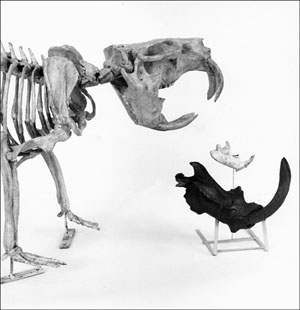Browse "Biology"
-
Article
Ornamentals
Ornamentals, in horticulture, include both woody and herbaceous plants used primarily as amenities.
"https://d2ttikhf7xbzbs.cloudfront.net/media/media/efd43801-3741-4547-a9e5-cdc7c21d6b0a.jpg" // resources/views/front/categories/view.blade.php
https://d2ttikhf7xbzbs.cloudfront.net/media/media/efd43801-3741-4547-a9e5-cdc7c21d6b0a.jpg
-
Article
Palynology
Palynology is the study of spores and pollen, has many applications in botany, geology and medicine.
"https://development.thecanadianencyclopedia.ca/images/tce_placeholder.jpg?v=e9dca980c9bdb3aa11e832e7ea94f5d9" // resources/views/front/categories/view.blade.php
https://development.thecanadianencyclopedia.ca/images/tce_placeholder.jpg?v=e9dca980c9bdb3aa11e832e7ea94f5d9
-
Article
Population Genetics
Population genetics is the area of genetics that studies the distribution of genes (the units of genetic inheritance) and genotypes (the genetic complement at one or more loci), and the mechanisms determining genetic variability within a population.
"https://development.thecanadianencyclopedia.ca/images/tce_placeholder.jpg?v=e9dca980c9bdb3aa11e832e7ea94f5d9" // resources/views/front/categories/view.blade.php
https://development.thecanadianencyclopedia.ca/images/tce_placeholder.jpg?v=e9dca980c9bdb3aa11e832e7ea94f5d9
-
Article
Quaternary Vertebrate Fossils
Mountainous zoneThe unglaciated areas of the Yukon Territory within the Cordilleran part of the mountainous zone contain the most productive Pleistocene (about 2 million to 10 000 years ago) VERTEBRATE fossil localities in Canada.
"https://d2ttikhf7xbzbs.cloudfront.net/media/media/c045a7d3-cd66-434a-94d2-68419b4652f5.jpg" // resources/views/front/categories/view.blade.php
https://d2ttikhf7xbzbs.cloudfront.net/media/media/c045a7d3-cd66-434a-94d2-68419b4652f5.jpg
-
Article
Silviculture
Silviculture is the branch of FORESTRY that deals with establishing, caring for and reproducing stands of trees for a variety of forest uses including wildlife habitat, timber production and outdoor recreation.
"https://development.thecanadianencyclopedia.ca/images/tce_placeholder.jpg?v=e9dca980c9bdb3aa11e832e7ea94f5d9" // resources/views/front/categories/view.blade.php
https://development.thecanadianencyclopedia.ca/images/tce_placeholder.jpg?v=e9dca980c9bdb3aa11e832e7ea94f5d9
-
Article
Sterilization of Indigenous Women in Canada
The practice of sterilization arose out of the eugenics movement and has a long, often hidden history in Canada. Sterilization legislation in Alberta (1928–72) and British Columbia (1933–73) attempted to limit the reproduction of “unfit” persons, and increasingly targeted Indigenous women. Coerced sterilization of Indigenous women took place both within and outside existing legislation, and in federally operated Indian hospitals. The practice has continued into the 21st century. Approximately 100 Indigenous women have alleged that they were pressured to consent to sterilization between the 1970s and 2018, often while in the vulnerable state of pregnancy or childbirth.
"https://d2ttikhf7xbzbs.cloudfront.net/Nikawiy Nitanis.png" // resources/views/front/categories/view.blade.php
https://d2ttikhf7xbzbs.cloudfront.net/Nikawiy Nitanis.png
-
Article
Montréal Insectarium
Opened on 7 February 1990, the Montréal Insectarium is part of the “Space for Life” network, which includes Montréal’s Biodome, Planetarium and Botanical Garden.
"https://d2ttikhf7xbzbs.cloudfront.net/media/media/34dcd770-a882-419d-91b2-c4ca29f2fbdd.jpg" // resources/views/front/categories/view.blade.php
https://d2ttikhf7xbzbs.cloudfront.net/media/media/34dcd770-a882-419d-91b2-c4ca29f2fbdd.jpg
-
Article
Tommy Douglas and Eugenics
Tommy Douglas — the father of socialized medicine in Canada and one of the country’s most beloved figures — once supported eugenic policies. In 1933, he received a Master of Arts in sociology from McMaster University for his thesis, “The Problems of the Subnormal Family.” In the thesis, Douglas recommended several eugenic policies, including the sterilization of “mental defectives and those incurably diseased.” His ideas were not unique, as two Canadian provinces (and 32 American states) passed sexual-sterilization legislation in the 1920s and 1930s. However, by the time Douglas became premier of Saskatchewan in 1944, he had abandoned his support for eugenic policies. When Douglas received two reports that recommended legalizing sexual sterilization in the province, he rejected the idea.
"https://d2ttikhf7xbzbs.cloudfront.net/media/new_article_images/Eugenics/Eugenics_congress_logo.png" // resources/views/front/categories/view.blade.php
https://d2ttikhf7xbzbs.cloudfront.net/media/new_article_images/Eugenics/Eugenics_congress_logo.png
-
Article
Triticale
Triticale (Triticosecale Wittmack), the first man-made crop species, is initially produced by crossing wheat (genus Triticum) with rye (Secale), and resembles wheat.
"https://d2ttikhf7xbzbs.cloudfront.net/media/media/968ada8b-613f-4a8f-9cfe-228d13b3a75d.jpg" // resources/views/front/categories/view.blade.php
https://d2ttikhf7xbzbs.cloudfront.net/media/media/968ada8b-613f-4a8f-9cfe-228d13b3a75d.jpg
-
Article
Zooarchaeology
In Canada most zooarchaeologists study teeth, bone and marine shells, because these materials are commonly preserved on archaeological sites. Preservation of specimens depends on what happened to them before burial, the rate at which they were buried, and the burial environment.
"https://d2ttikhf7xbzbs.cloudfront.net/media/media/c7b9ec57-7920-40cb-8cc4-704d9f75d445.jpg" // resources/views/front/categories/view.blade.php
https://d2ttikhf7xbzbs.cloudfront.net/media/media/c7b9ec57-7920-40cb-8cc4-704d9f75d445.jpg
